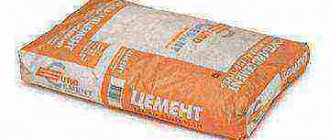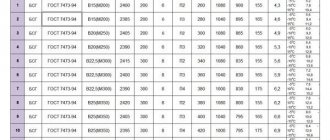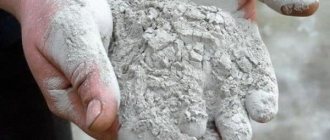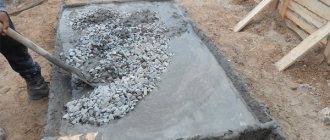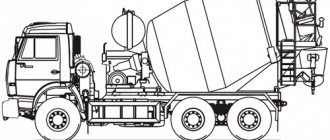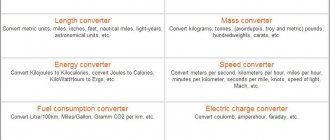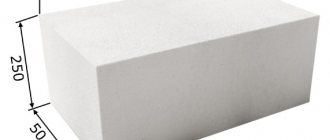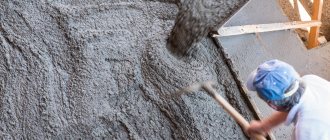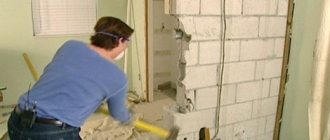Construction requires strict compliance with standards and technologies, which ensures the stability, strength, and reliability of the structures being built. When using concrete mixtures, important attention is paid to the quality, composition, and method of preparing the material.
When constructing large-scale private or industrial projects, there is a need for large volumes of building material. It is not convenient to make mixtures and solutions yourself using a concrete mixer. In such a situation, special equipment comes to the rescue - a concrete mixer. It allows you to produce and transport large volumes of material, ensuring their uninterrupted supply to the construction site.
Where does the concrete in a concrete pump come from?
A standard concrete pump receives concrete from a mixer, which delivers the material to the construction site. The mixer drives up to the concrete pump truck from behind and unloads concrete into the pump's receiving hopper.
When pouring with a concrete pump, concrete is delivered to the site with a mixer
The mixer drives up to the back of the pump to unload concrete.
You can pour concrete using a hybrid - a unit that combines the functions of a mixer and a concrete pump. The hybrid delivers concrete to the site in a rotating barrel, like a mixer, and then pours the material into the formwork using a boom, like a concrete pump.
The mixer pump delivers concrete to the site and pours it using a boom
Concrete mix composition
I know that skeptics will say that you can mix concrete just as well with a shovel. Perhaps if you are making flowerpots. Concrete prepared using a mechanized method is 40% stronger than hand-mixed concrete, due to the uniform mixing of substances. In addition, using a concrete mixer, you will not run out of steam, as can happen after the first manual mixing.
Who knows what concrete is made of? I know and will remind those who have forgotten.
The main components are:
- cement (high quality grade not lower than M400);
- sand (cleared of debris and washed of clay);
- crushed stone or ASG (available in different fractions).
A fraction, to put it simply, is the size of stones that fit into certain values (for example, from 20 to 40 mm, etc.) There are fractions for ordinary concrete. These are pebbles with a maximum size of 80 mm. For reinforced concrete structures, mixtures of sand and gravel are used, the size of which should not be more than 30 mm. But for the foundation they take OPGS with a grain size from 5 to 20 mm.
In general, at your request, manufacturers can make absolutely any size of crushed stone and sell it to you at a reasonable price.
All components of the building mixture have special requirements. You can’t just take and mix a solution; you must first make sure the quality of each component:
- Portland cement must be fresh, made recently. Do not give in to persuasion and discounts. Most likely, they want to sell you a product with an expiration date. This is very, very unprofitable. You will buy cheap, but the quality will suffer. You may even have to redo everything. By the way, you can prepare concrete only with M400-M500 cement.
- Sand comes in different varieties. For each type of concrete, different fractions are chosen. Do not buy sand with debris and lumps of clay. You cannot mix the solution with such sand. Either you will have to wash it yourself or you can throw all the concrete down the drain. The size of the sand grains should be 1.5-5 mm.
- Water is also very important. The solution should be mixed only with clean, odorless water (which indicates some kind of chemical impurities) and debris.
- It is better to immediately buy enriched ASG. I think saving a little money will make you regret it when you start sifting the sand and gravel mixture yourself. Besides the fact that it will take a long time, you will be very tired. By the way, one 10-liter bucket with ASG weighs 15 kg. When I was 17 years old, I experienced all the “delights” of enriching PGS through a metal lattice in a frame that my father made himself. But this is my subjective opinion. You decide.
Here's another thing that's important. Various substances can be added to the mixture to improve the quality of concrete or make it easier to lay. There is a huge variety of them. Let's divide them into main groups, and you decide which one suits you best. So, the additives:
- Plasticizing. They make the solution fluid and pliable for pouring.
- Water repellent. They improve the quality of the finished structure in 3 areas: strength, frost resistance, and resistance to the destructive effects of water.
- Modifying. Such additives can increase the setting time of the mixture or, on the contrary, slow it down. This can help beginners pour the solution better.
- Mineral reinforcing. They increase the strength of structures and reduce shrinkage cracking.
Each type of additive must come with instructions. Read it in advance. For example, it is correct to pour some substances only after water, while others are allowed to be mixed into the finished mixture.
Preparing for work
Before starting work, the driver selects a location for the concrete pump , taking into account 3 requirements:
- the pump boom must reach the filling point
- the concrete mixer must have access to the pump receiver hopper
- It must be possible to install concrete pump support legs
Before pouring concrete, the concrete pump is installed on support legs.
Platform with equipment – top view. The dimensions of the site allow you to place on it a concrete pump with extended support arms and a mixer with concrete
The correct choice of pouring location allows you to avoid unnecessary rearrangements of equipment and loss of time.
Our experienced drivers are able to place the pump in limited spaces and know how to deliver concrete to the most inaccessible places while maintaining order on the site.
Recommendations for mixing the solution
Each master will certainly give you his recommendations if you ask him. And I will give too, even if you don't ask. And if you don’t ask anyone and no one gives you sensible advice, then how can you make concrete?
- Before starting work, be sure to check the equipment for operability, turn it at idle, listen to how the engine works. Inspect the electrical cable for damage. Wipe off protective lubricant if the machine is new.
- Be sure to place the concrete mixer on a level surface. It would be correct to place some kind of shield and check the horizontal level. Make sure there is no distortion. This can create vibration and, as a result, increased load on the engine, which can even lead to engine failure.
- If you are unsure of the recipe, do a test batch first. Let it be half of the whole portion. If you are a beginner and it seems to you that the solution is a little dry, do not rush to add water. Concrete that is too wet will separate into fractions and its quality will deteriorate significantly. It can also crack when shrinking. Add water in small portions and observe. Better yet, buy a plasticizer. Its consumption is only 50 g. for 1 bucket of cement.
- Do not start the machine with material loaded. Correctly, first turn it on and only then start adding ingredients.
- How to determine that the solution is ready? Unload some of the compound and make notches with a trowel. The solution should hold its shape and the ridges should not blur. The cement mixture itself must be evenly mixed, smooth and plastic.
- To prevent the solution from sticking to the walls, it is recommended to pour 1 bucket of gravel after loading water and cement. The stones will allow you to mix the cement evenly and remove the adhering layer from the walls and blades.
- Do not forget to rinse the container with water after each batch. Pour 1 bucket and swirl for a few seconds. This water can then be used for a new batch of concrete.
- If sand and cement stick to the inside of the tank, this can reduce the content of these components in the finished solution. "Underweight" can affect the quality of concrete. Therefore, either do not allow sticking, or add 10% more of these components.
- If it happens that the concrete has dried up, use drastic measures (but do not abuse it, otherwise you will break the device). Throw broken bricks into the tank and swirl until the container is clean. Then shake it all out of the drum and rinse it with water.
- Don't forget to wash the outside of your car. It will be nice for you and others will see what a caring owner you are.
Starting the pump - pumping the mixture
After installing the equipment, the pump starts, during which the concrete pipes are prepared for pumping concrete. To do this, a special mixture is driven through the pipes to start the pump (cement laitance), which serves to lubricate the concrete pipes and prevent concrete from sticking to the walls of the pipes.
Our company provides the mixture and standard pump starting service as a gift.
However, if you have to work with additional concrete pipelines (route) of increased complexity or length, a standard pump start is not enough. In such cases, to start, you need to order an additional 0.5-1 cubic meters. cement laitance on a mortar-concrete unit.
Forced action concrete mixer and gravity unit
There are no fundamental differences in the order of mixing the solution in these machines. The only difference is in the operating principle of the units. The forced one actively mixes with blades, and the gravitational one uses the rotation of the drum itself and the force of universal gravity.
The main thing here is to take the right time. The forced one does its job 2 times faster.
The forced-type concrete mixer has different sizes and modifications:
- rotary;
- cascade:
- planetary.
Such units can operate continuously, when the components can be loaded and the finished mixture can be unloaded at the same time. You can safely buy such equipment if you want to open a mini concrete production plant. But more often these installations are bulky and are used in production.
Pouring concrete with a pump
The process of pouring concrete with a concrete pump does not require special skills or special labor costs from the client. To operate the pump, one person is enough to direct the hose from which the concrete flows into the formwork. At the same time, the pump driver uses a remote control to control the movement of the boom on which the hose is attached.
One person is enough to operate the pump hose
The pump driver controls the boom using the remote control
When using a pump, pouring concrete goes very quickly - one shift of machine operation (3 hours) is usually enough to pour the foundation of a private house.
The technical capabilities of the pumps make it possible to pour 150-180 cubic meters of concrete per hour, but in fact the pouring speed also depends on the timeliness of supplying concrete to the site and the need to rearrange equipment.
To increase the range of concrete supply, additional concrete pipes are sometimes used - route . Everything you need to create a route is provided free of charge.
Pouring concrete using additional concrete pipes (routes)
Types of concrete mixers
Maybe you've already bought a concrete mixer, or maybe you're just about to. We are all human and tend to do the opposite: we go to the store and fall into suspended animation at the sight of a variety of goods. I understand your feelings and now I suggest you do the right thing. First, let’s see what kind of units there are for “homemade” concrete mixing, and how they differ.
Helpful information:
- How to buy a house with land
- How to properly install a door stop?
- How to choose the right plastic windows
- How to properly glue non-woven wallpaper
- Concrete proportions: how to mix correctly
- How to prepare a solution for plastering walls from...
There are only three types. See:
The first group is gravitational
Everyone knows what they look like because everyone has seen them in their neighbors. But perhaps you didn’t pay attention that such concrete mixers can be electric or manual. Manual drive is when you have to “turn the drum” (as in the Field of Miracles) with your hands. Yes, it’s a little complicated, but it’s still easier than kneading with a shovel. But an electric drive is the best option to save energy and get quite a decent result.
I want to see everything!
I want to see everything!
The operating principle of gravity mixers is based on the force of gravity. The blades, which are fixed inside on the sides of the drum, lift the mixture up, and it falls down again. By repeating these steps many times, the components are evenly mixed with each other.
The second type of concrete mixers is forced
Other forces are already at work here. Apparently, the ingredients are forced to be mixed. It looks like this: sand, cement and water are poured into a vertical container and they begin to mix with the blades that are inside. In general, the whole process looks like in a home blender when you make an ice cream shake. Introduced? Such machines run on electricity and spend much more of it than their gravitational counterparts.
I heard ancient legends say that concrete mixers with a crown drive are powerful, invincible, make sounds like a mountain rockfall, but are reliable and loyal to man. That's right, I agree. Such units are much easier to repair and are not expensive. The machines operate on a rim drive from a 220 volt network and are very economical. In the photo below you can see the crown, which is located around the entire circumference of the tank. It rotates due to a gear driven by a motor.
There are also gear type machines. They are more reliable, but failure of one gearbox part requires a complete replacement of the engine. The rotation of the tank occurs due to the shaft, which is connected to the gearbox.
What more can be said about the variety of concrete mixers. Well, for example:
- They may vary in drum size. So, you can find miniature specimens with a capacity of 70 liters. The most serious ones have a 500 liter drum. For domestic purposes, the best option is a capacity of about 150-180 liters.
- There are mobile units on wheels, and there are stationary ones.
- A decisive characteristic may be the ability to connect the machine to a 220 volt household power supply. Some concrete mixers only operate on 380 watts.
- The devices also differ in drive power. It comes from 0.37 to 1.5 kW.
For information, I will add a third type of concrete mixer, which is called vibrating. But this is a fairly large and complex structure connected to a silo, which is used in industry. The mixing process in such a unit occurs due to vibration forces. It is unlikely that you will want one of these in your home. Although, who knows.
Flushing the pump
The pump is flushed right on site immediately after pouring concrete, before the material hardens in the pipes. This integral part of the technological process is included during the work shift, like other auxiliary operations.
Washing usually takes about 40 minutes and occurs in 2 stages:
- removing concrete residue from the boom
- removing concrete from the receiving bunker
The pump is flushed on site immediately after concrete is poured.
When cleaning the boom, 0.2 - 0.3 cubic meters of usable concrete are removed from the pipes. At the request of the client, this material can be poured into any form or container provided by the customer.
The remaining concrete from the receiving hopper is removed using water that comes from a tank installed on a concrete pump. The remaining concrete along with water is poured out in a place previously agreed upon with the customer.
Go to the equipment catalog
Watch a video of pouring concrete with a pump. You'll get an idea of the process in just 1 minute 54 seconds.
Are you planning to fill? Want to know more?
Proportions of components and operating procedure
It seems that the components have been sorted out. Now it’s time for their number. That is, we will find out what rules and proportions must be observed to prepare concrete for one purpose or another.
First, I will say (or remind you) that concrete is divided into grades based on strength. And each type of strength is used for specific purposes.
- Thus, grade M100 is used as an auxiliary mortar before pouring the main foundation. It is used as a substrate and reinforcement is attached to it.
- M150 is suitable for paving small buildings, making screeds, and concreting paths.
- M200 is also more often used in home repairs and construction. They pour foundations, cover garage floors and make paths.
- M300 is already stronger and is used for the construction of building frames with medium load.
- The M350 is already used for more serious purposes. These are solid foundations, stairs, floors between floors, columns.
- M400 – M500 are particularly durable grades. They are used in industrial construction. They make bridges, subways, dams.
How much crushed stone in 1 cubic. m of concrete
The average proportions of concrete in parts look like this: 1:3:5. This means that for 1 part of cement there are 3 parts of sand and 5 parts of crushed stone. Practical builders say that it is more reliable to use the formula 1:2:4.
With water it's a little different. The average volume is 0.4 parts. But the amount of liquid depends on what brand you want to get and also on the moisture content of the sand. There are special calculators and tables where experienced craftsmen share their proven recipes for ideal concrete. The unspoken rule is that the amount of water should not be more than half the volume of the binder (cement).
The proportions of substances for the foundation consist of the following ratio: 8 parts OPGS, 1 part Portland cement, 0.5 parts water. By the way, you can measure proportions in shovels or buckets.
Please note that at one time in a concrete mixer you can mix a solution with a volume of 2/3 of the total size of the tank:
- In a 160 liter concrete mixer you can make 120 liters of solution at a time.
- For a concrete mixer of 180 liters, you need to calculate the number of components so that the total volume does not exceed 140 liters.
If you count in buckets, then for 1 batch in concrete containers with a volume of 150-180 liters you need to put 1 bucket of cement, 2 buckets of sand, 4 buckets of gravel and half a bucket of water.
To avoid overdoing it with water, do a test batch. Do not pour all the water at once. Pour in 2/3 of the intended volume and then gradually add as needed. This way you can choose the optimal quantity.
If you have read the instructions for mixers, then you know that it describes the operating procedure and the sequence of laying out the components. Don't ignore this point, it's really very important.
In general, before starting work, if the machine is completely new or has been idle for a long time, carry out preparations. Check the lubrication on the mechanical elements, turn the mechanism at idle, make sure there are no extraneous sounds.
The loading order itself looks like this:
- We install the drum at an angle of 45 degrees and turn it on at idle.
- Pour water into the tank.
- We pour cement.
- Next we put OPGS.
- Stir (no more than 5 minutes).
- We unload the solution by tilting the drum using a lever or wheel.
Wait 1-2 minutes between loading components.
Don’t forget to clean the drum after each batch (well, at least do it after 3-5 cycles). To do this, simply pour a bucket of water into the tank and turn it on for a few seconds. You can add a couple of shovels of gravel. Timely cleaning will extend the life of the unit, and during operation will prevent the cement mixture from sticking to the walls.
